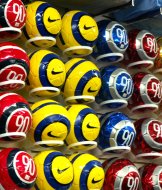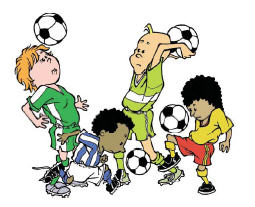There are no restrictions on the color of the game ball.
However, many teams have balls that have a similar color scheme as their uniforms.
It is best to use a ball that contrasts with the player's uniform so it can be more easily seen by players, coaches, fans, and referees.

The ball must be inflated to the proper pressure.
A good rule of "thumb" is to hold the ball with your thumbs on the top of the ball and try to dent the ball with your thumbs.
If you can create a small dent with some effort, the pressure is approximately correct.
If you can easily dent the ball, it likely needs more air.
The ball must be spherical.
Spherical means that the ball is round in all dimensions.
This seems simple but may not be. Many players use their ball as a seat when a bench is not available.
This deformation of the ball under the weight of the player may cause the ball to become less spherical over time.
The easiest way to determine if the ball is spherical is to simply toss it up in the air in a spinning motion.
If it spins in a tight pattern without any big fluctuations, it is spherical.

Every ball used in the game must be inspected by the referee but how many balls are needed?
It depends upon the age group, their skill level, and the field conditions.
The older the age group, the more chance that the ball may be kicked a long distance from the field.
Players with more skill should not need to send the ball far distances and can keep the ball close and pass to where they intend the ball to go.
If the field is surrounded by a woods, cornfield, or lake, a ball that is kicked there may take a long time to find.
For all these reasons, it is generally a good idea to have inspected more than one ball before the kick-off.